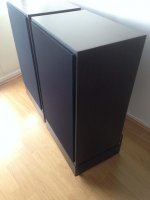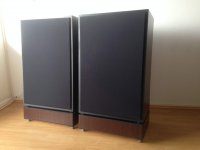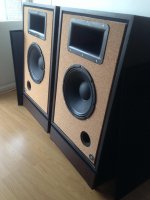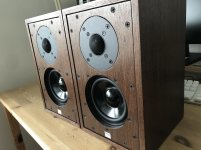Some of what we hear and like or prefer over other is how our brains do their magic; sometimes this can't be measured with test equipment. I can immediately tell sometimes the improvements made between one capacitor vs another but I think these things may be beyond measurement; at least without very sophisticated and expensive test and measurement equipment. I spent my entire career as Technician and Engineer surrounded by test and measurement equipment so I know the meaning of accurate and repeatable measurements with known good and properly working instruments (verified and calibrated every 6 months traceable back to NIST standards). I was also a musician so I do most of my final tweaks and tuning based on what my ears are telling me. If there are particular issues; I do troubleshooting as I was always taught. I have a calibrated mic and interface; REW and ARTA now but am still learning how to use this "new" technology. Again; we can compare this to art; sometimes it just comes down to personal tastes or preferences and that there is (or MAY be) more than just one "right" "answer".
Great post! And you are right about another thing measurement equipment. I don't think there ever will be test equipment to measure absolutely everything either which is why audio is such a fascinating hobby. The human brain is a complicated piece of organic machinery but some things are known about and it is does do things in a predictable way sometimes. We know that changes in contrast of things can be picked up over even the most sophisticated machinery sometimes, but it is often confused with subjective words like I had a feeling or something wasn't right 🙂 The other thing is it can even make up things that are not there, fill in the blanks in a very intelligent way. You would know that being a musician play a familiar song and pause a second, when you continue you pick up the beat exactly were you left off, as the brain continues to make it up in the pause. The phenomena works for many things though and it is a great source of how magicians fool you into seeing or not seeing slight of hand among other things. All our senses are flawed and extremely sensitive at the same time, machines only measure exactly what they are designed to measure. Our brains are continually alert to and cancelling out thousands of stimulus (possibly millions) of things at once via our senses. Measurements only do so much.
Boden,
Noone is going to perform the duty for you, and make a proof.
There is nothing wrong with objectivity.
I try to avoid subjectivity, and I hate using words like Veiled when describing a change in sound, but I have no other vocabulary.
I can't measure the "veil lifting" but I could measure the TF of each system.
Relieving the amplifier of complex impedance loads, and the effects this can have on the amplifiers feedback loop, is enough of a reason for me to advocate active filters and amplification.
(In other words, a passive zobel network/impedance equalizing network, has probably less affect on the sound, that the lack of a zobel - I would even use on fullrange drivers)
I like this also. Thanks for sharing.
Last edited:
Hi Westsounds,
Regarding your enclosures - they look great, neat and purposeful - I have done same in the past. Only issue is - they could be easily scratched or damaged but it does not take long to add another layer again!
I'm following discussion about DSP/active crossover, if I remember right, BBC had ls5/9 initially made only with active crossover and later made 'hi-fi" version with passive filter for marketing reasons. So, no down-side going active route anyway.
There is only one thing that passive is maybe better - impedance correction for drivers as the passive components interact with the voice coil to flatten the impedance curve - how are we going to do that with DSP - just applying EQ is not the same...
Regarding your enclosures - they look great, neat and purposeful - I have done same in the past. Only issue is - they could be easily scratched or damaged but it does not take long to add another layer again!
I'm following discussion about DSP/active crossover, if I remember right, BBC had ls5/9 initially made only with active crossover and later made 'hi-fi" version with passive filter for marketing reasons. So, no down-side going active route anyway.
There is only one thing that passive is maybe better - impedance correction for drivers as the passive components interact with the voice coil to flatten the impedance curve - how are we going to do that with DSP - just applying EQ is not the same...
I did find some higher quality vinyl wrap at Home Depot; it looks similar to yours. As I said, the contact paper brand I have tried in the past just isn't all that good. What I found is durable enough to cover a kitchen table with so the quality and strength should do nicely. From the photos; your boxes do look very much like real exotic wood for sure.
My last vinyl wrap was years ago with Pi3 speakers I made - they where 2-way 12inch woofer with horn - great sounding monsters - ZERO WAF - so they had to go after short time... but because of sheer size&cost went with vinyl wrap and they were good enough looking as long term solution.
For the Mini monitors I used generic Veneer of industrial quality - nothing special - I just wanted to be dust/water resistant to withstand the years of use.
There is of course difference in appearance but this is why it took 2 months, just to veneer entire enclosure with all the sides... :-(
For the Mini monitors I used generic Veneer of industrial quality - nothing special - I just wanted to be dust/water resistant to withstand the years of use.
There is of course difference in appearance but this is why it took 2 months, just to veneer entire enclosure with all the sides... :-(
Attachments
Boden,
Noone is going to perform the duty for you, and make a proof.
There is nothing wrong with objectivity.
I try to avoid subjectivity, and I hate using words like Veiled when describing a change in sound, but I have no other vocabulary.
I can't measure the "veil lifting" but I could measure the TF of each system.
Relieving the amplifier of complex impedance loads, and the effects this can have on the amplifiers feedback loop, is enough of a reason for me to advocate active filters and amplification.
(In other words, a passive zobel network/impedance equalizing network, has probably less affect on the sound, that the lack of a zobel - I would even use on fullrange drivers)
+1
Personally I always put it down to the removal of the series inductor as I don't hear much improvement in the treble.
To my ears passive xovered speakers just always seem to have a mushy, soft bass that does not sound like the actual instrument producing that sound.
In the end different people hear differently.
I've met one guy who could hear different external clocks with his digidesign convertors. He never got below 95% accuracy in a level-matched blind test.
And that should not be possible even though due to a design quirk digidesign convertors can actually be improved with external clocking.
I took the battery out of the kitchen clock because the noise it made drove me nuts when I was in the living room listening to music or watching TV.
+1
Personally I always put it down to the removal of the series inductor as I don't hear much improvement in the treble.
To my ears passive xovered speakers just always seem to have a mushy, soft bass that does not sound like the actual instrument producing that sound.
In the end different people hear differently.
I've met one guy who could hear different external clocks with his digidesign convertors. He never got below 95% accuracy in a level-matched blind test.
And that should not be possible even though due to a design quirk digidesign convertors can actually be improved with external clocking.
I took the battery out of the kitchen clock because the noise it made drove me nuts when I was in the living room listening to music or watching TV.
Interesting, mushy bass you say. I've never lived with a fully active set up so I'm quite excited to try.
Yes, they always seem to produce sound for just a fraction longer than they should.
Andi Munro put it a bit more extreme, he said that if you route a single kick drum hit through a passive speaker you can go out of the control room, make a cup of tea and it is still coming out of the speaker when you get back. 😉
Andi Munro put it a bit more extreme, he said that if you route a single kick drum hit through a passive speaker you can go out of the control room, make a cup of tea and it is still coming out of the speaker when you get back. 😉
Last edited:
Yes, they always seem to produce sound for just a fraction longer than they should.
Andi Munro put it a bit more extreme, he said that if you route a single kick drum hit through a passive speaker you can go out of the control room, make a cup of tea and it is still coming out of the speaker when you get back. 😉
Hmm, I can understand why this may happen with components in line I suppose especially when you put it in the humorous dramatic sense like that. Perhaps there is some method in that actually. The amps are delivering signal, power and driving direct and not passing through anything. It has to make sense really. You know in all my years as an audiophile I've had hundreds of great speakers but very little experience of active crossovers.
But I have allways loved old epos speakers which have no crossovers and admired their speed and transparency perhaps that would explain it. But they weren't great unless matched perfectly with an amplifier and the room. Then they were magic.
Mushy bass has more to do with speaker box alignment- reflex vs sealed vs TL, vs FLH. Etc. also XO topology. Is it transient perfect or time aligned? What does step response look like. Well designed tapered TL always has tighter bass than simple reflex.
Same box, same port, same driver.
That's it Charles, all other factors the same, it would have a complete advantage I'm sure. Comparing one design with something different is not really a comparison.
I always use an inductor with the lowest possible DCR in a woofer circuit; that certainly helps. I recently got a Jantzen "C-core" for use on my SB29. This uses a toroid core; the DCR is only 0.078 Ohms; lower than I think my DMM can accurately measure! It only has one winding layer; the toroid gives what I believe to be maximum inductance with a minimum number of wire turns. I did place a 10 AWG jumper across it for just testing the effects the inductor was having on the intended low pass rolloff. I couldn't tell any difference at all in the low bass between the short circuit strap or the inductor. This is a closed box with Aperiodic vent; the bass is very strong and believable here.
C-Coil - Toroidal Core - Jantzen-audio.com
http://www.jantzen-audio.com/wp-content/uploads/2020/06/C-Coil-Data.pdf
http://www.jantzen-audio.com/wp-content/uploads/2020/05/C-Coil-Values.pdf
They claim 700 WRMS; I am using a new Crown amplifier capable of 450 W at 4 Ohm; 330 W at 8 Ohms. I'm sure I'm doing 200 W peaks at least into the SB29 with zero signs of stress, strain; no mushy "slow" or "sloppy" bass here at all; very clean, very real, very believable....(the SB29NRX75-6 has a 3 inch VC and is rated for 200 W.)
C-Coil - Toroidal Core - Jantzen-audio.com
http://www.jantzen-audio.com/wp-content/uploads/2020/06/C-Coil-Data.pdf
http://www.jantzen-audio.com/wp-content/uploads/2020/05/C-Coil-Values.pdf
They claim 700 WRMS; I am using a new Crown amplifier capable of 450 W at 4 Ohm; 330 W at 8 Ohms. I'm sure I'm doing 200 W peaks at least into the SB29 with zero signs of stress, strain; no mushy "slow" or "sloppy" bass here at all; very clean, very real, very believable....(the SB29NRX75-6 has a 3 inch VC and is rated for 200 W.)
Same box, same port, same driver.
Then it might be the XO design - if the impedance is not corrected there may be a high impedance peak near say, 55Hz where the bass kick drum is and not much current is going to pass through. Or if the time alignment is not right, the leading edge of the treble is more than a millisecond off, the time delay causes temporal smearing. My experience is that a well designed transient perfect passive is as good or better than active XO. That’s one reason why I switched over to passive XOs now after years doing active. Active has its place though - pro audio or sound reinforcement for shows requires much more flexibility and setups are changing daily. I am developing a custom 8 ch DSP with AKM ADCs and DACs with a custom MCU to control it all for this reason.
Last edited:
To my ears passive xovered speakers just always seem to have a mushy, soft bass that does not sound like the actual instrument producing that sound.
did not, the now gone, avi hifi advocate active speakers for the same reson, and they where quite dogmatic about it, and people got upset and tried to prove this was wrong
I think woofer resonance, or any resonance causes "hangover", whether that be the woofer, or a large impedance peak on the midrange/tweeter and a perfect phase alignment at crossover while it will help a lot of things, will not ameliorate those.
So my opinion, is that impedance networks are useful, whether you use active or passive filters.
So my opinion, is that impedance networks are useful, whether you use active or passive filters.
did not, the now gone, avi hifi advocate active speakers for the same reson, and they where quite dogmatic about it, and people got upset and tried to prove this was wrong
As does Billy Woodman founder of ATC.
He 'blames' amplifier damping factor and goes as far as to say that it is audible in the midrange as well which is why he uses 16Ω mids as that doubles the DF.
He could save himself some money by using 8Ω units and half the mid amp without having to change the spec sheets.
Couple of guys whose ears I trust went to ATC and spent a day comparing otherwise identical speakers. According to them it was no contest, not even close so they obviously bought actives for their studio.
Then it might be the XO design - if the impedance is not corrected there may be a high impedance peak near say, 55Hz where the bass kick drum is and not much current is going to pass through. Or if the time alignment is not right, the leading edge of the treble is more than a millisecond off, the time delay causes temporal smearing.
The drivers in my case were Tannoy DCs, the physical offset between the voice coils is measured in µseconds.
As it happens at some point Tannoy introduced SynSource, an allpass network that reduces timing differences to zero. However it did consist of an array of inductors and Tannoys own engineers said that it was forced upon them by the marketing department and the cure was far worse than the disease as it smeared everything which lead me to assume that the culprit is the series inductor.
I can see a place for passives and active crossovers and both have their pros and cons. Sound will always be a subjective thing to the listener. Active completely trumps passives in terms of flexibility and control though I don't even think it's close especially for live application and moving gear a lot to changing venues. Although a passive and EQ will get close I'm sure. I'm looking forward to experimenting with the listening of active. I only wish I had the knowledge to play with the passive side of crossovers as easily as I would when I get the active up and running. But even if you are a passive specialist I still can't see it comparing with ease of control and the ability to make the smallest of changes and with minimal effort. When you think about the number of different listening environments there are its hard to understand why more serious audio enthusiasts have not gone active and how standardised high end speakers sell at all, but then again I've avoided active most of my life. I wonder if I will become a convert after this 🙂
The drivers in my case were Tannoy DCs, the physical offset between the voice coils is measured in µseconds.
As it happens at some point Tannoy introduced SynSource, an allpass network that reduces timing differences to zero. However it did consist of an array of inductors and Tannoys own engineers said that it was forced upon them by the marketing department and the cure was far worse than the disease as it smeared everything which lead me to assume that the culprit is the series inductor.
I had a pair of little red monitors using that phase shift network. Took it out because it really didn't improve the sound at all in my opinion at the time (mid 8ies). Could not make acoustic measurements then, unfortunately only companies could afford the equipment you can now have for a couple of hundreds of Euro's.
- Home
- Loudspeakers
- Multi-Way
- What's the best 5 inch driver for a small sealed box same as the LS3/5A. SPH-135TC ?



